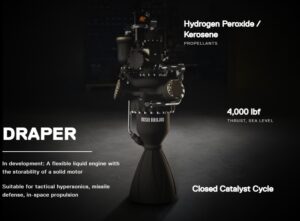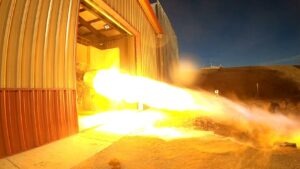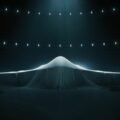Colorado-based aerospace and defense contractor Ursa Major has announced the first successful “hot fire” test of its liquid Draper thruster. Funded by the Air Force Research Laboratories (AFRL), Ursa Major first introduced its 4,000 lb thrust closed-cycle engine in May 2023, with the ultimate goal of having a fully functional engine that can operate in the atmosphere or space until the end of 2024.
According to a company statement, this successful May test puts Draper’s development ahead of schedule, “exceeding industry standards.”
“We are excited at how quickly the development program has progressed and look forward to putting the engine to hypersonics and space applications in the coming years,” explained Brad Appel, Chief Technology Officer at Ursa Major.
The non-cryogenic fuel makes the Draper ideal for hypersonic and space applications
In the company’s statement, the developers of the Draper engine say its ability to create a powerful thrust profile without the use of cryogenic propellants offers spacecraft engineers unprecedented versatility. Fuels that do not need to be stored at sub-freezing temperatures save significant space on liquid oxygen engines, resulting in the ability to carry significantly more fuel into space.

“Based on its thrust profile, the engine is not only capable of maneuvering objects in orbit, but doing so without completely depleting its propellant reserve, potentially allowing for additional mission functions,” the company explains.
According to Ursa Major, this level of agility is increasingly important as adversary nations develop multiple weapons platforms designed to disable or destroy America’s space assets. As this space race progresses, the company says, “the need for defensive technology will continue to grow.” That means engines like Draper that can provide the spacecraft with multiple shots into space before running out of fuel will become increasingly critical to protecting these space assets.


In promotional material for the engine in development, the company notes that the Draper is an evolution of their Hadley rocket engine in production. However, unlike Hadley, who is fueled by a combination of liquid oxygen and kerosene, Draper works with a combination of hydrogen peroxide and kerosene. According to the company, this change means that the Draper “combines the conservation attributes of a solid rocket motor with the active throttle control and throttle range of a liquid motor”. This combination, they explain, also provides Draper with “the maneuverability and flexibility needed for hypersonic defense.”
Air Force Research Laboratories Touts Engine Power and Maneuverability
While Ursa Major has a number of engines in development, including the 50,000 lb Ripley thruster and the 200,000 lb Arroway rocket thruster, the non-cryogenic liquid Draper thruster was specifically funded by the Air Force Research Laboratories. This funding included the design and construction of a specialized test stand at Ursa Major’s Berthoud, Colorado test facility, where this test firing took place. According to the company, this specialized test stand “has and will continue to allow greater testing capabilities and, in turn, faster iteration and development of the Draper engine.”


While there is no definitive timeline for the Draper’s real-world deployment, AFRL says it is impressed by the recent test firing and the rapid pace of engine development over the past twelve months.
“Perhaps the most impressive aspect of this program is the delivery of a versatile and storage rocket engine in such a short time frame,” said Dr. Shawn Phillips, Chief of the Rocket Propulsion Division at AFRL. “AFRL and industry are taking on the challenge that our USAF and USSF leadership has asked of us…to deliver faster capabilities, forge closer ties with industry, and leverage what already exists to deliver breakthroughs asymmetrical.”
“Thankfully, this is only the tip of the iceberg when it comes to what we are doing as a Team,” added Dr. Phillips.
Christopher Plain is a science fiction and fantasy novelist and chief science writer at The Debrief. Follow and connect with him X, learn about his books at plainfiction.com or email directly at christopher@thedebrief.org.